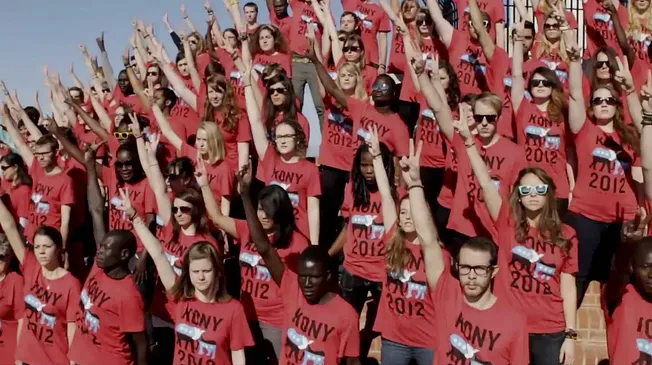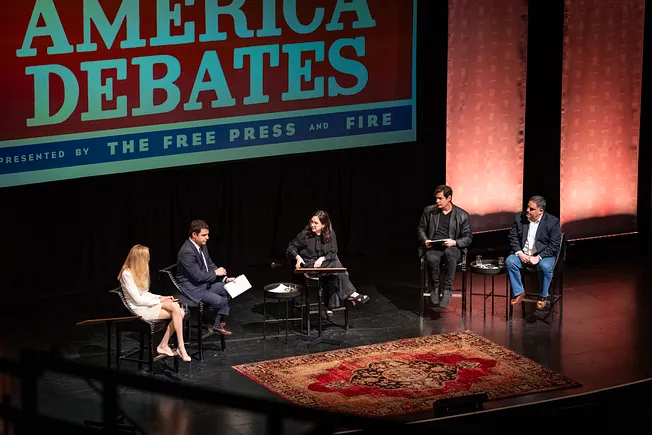Ten years ago today, the non-profit Invisible Children Inc., published a video on YouTube called “Kony 2012.” To date, it has been viewed 103 million times there and 18.7 million times on Vimeo, the platform where it was originally released.
On or around the same day, I was in class, in high school—I was a junior then—when my history teacher wrapped up early so we could attend a special assembly. We shuffled into the auditorium—usually we’d be there for a talk about how to fill out scholarship applications for college or a surprise appearance from our most famous alumnus, the rapper Wiz Khalifa—and onto the squeaky, gray, fold-up plastic chairs. Then, me and my fellow sixteen-year-olds were enlisted to fight an African warlord more than seven thousand miles away.
To get us amped up, we were shown a video. We couldn’t have imagined then that it would transform our relationship with the internet from that of passive enjoyment—until then we were there to lurk on Tumblr and instant-message our friends—to one of moral obligation. Now, we were expected to be online combatants in a never ending war on evil.
The video was a little less than thirty minutes long. But it managed to capture the imaginations of everyone in my high school—and every other teenager in every other high school across the country.
As Jason Russell, Invisible Children’s young, blonde, enthusiastic co-founder, explained the mission in the video, some of the girls in the auditorium cried. Kony, Jason told us, was an elusive, Ugandan warlord and leader of the Lord’s Resistance Army and he was terrorizing northern Uganda, capturing girls, turning them into sex slaves, and turning boys into child soldiers. There were montages of facially mutilated Ugandan people, and then other ones of kids dancing, slick graphics, a million jump cuts, a heart-tugging soundtrack including songs by Mumford & Sons and Nine Inch Nails, and a boy named Jacob weeping for his dead brother.
But there was good news for those who thought crimes against humanity were bad and who had new smartphones in their pockets – phones that had until then been mostly used to make plans with our friends and lie to our parents about where we were.
We were told that Kony would be captured if only we could Make Him Famous. That was the slogan. The logo was a donkey and an elephant and an olive branch. It fit snugly with another one of the campaign’s mottos: “One thing we can all agree on.”
The plan was to get a ton of kids, or more likely their parents (has there ever been a better reason to use the emergencies-only credit card than to stop a tyrant?), to buy $30 “action kits” which included two bracelets, a t-shirt, and a few posters and bumper stickers. Those who bought the kits—I didn’t, but my cousin did, and I thought her bracelet was amazing—were given “missions” like sharing the Kony video on Facebook, changing your profile picture to the logo, or tweeting at John Kerry, the secretary of state.
The whole drive was meant to culminate in an event called Cover the Night, on April 20, 2012, when all of us teen-activists would stay out past curfew, blanketing our towns with posters of Kony so that when the grown-ups woke up in the morning, they would have no choice but to just go get him already.
It was a simple story set against the chaos and moral confusion of the real world. “Enhanced interrogation techniques,” “IEDs” and “drone strikes” just didn’t roll off the tongue quite like “There is a man in the woods forcing kids to kill their parents.” We’d seen the coverage of Occupy Wall Street in Manhattan’s Zuccotti Park and marriage equality spreading across the country and then marijuana legalization and then the Arab Spring, and we wanted in on the action, too.
Never mind that by the time the Kony video came out, the Lord’s Resistance Army and Kony hadn’t been active in Uganda since 2006, and that they hadn’t mounted a large-scale attack anywhere since 2010. More children in Uganda in 2012 were affected by a mysterious nodding disease than the LRA. President Obama had already sent 100 U.S. troops to Central Africa in October 2011, to try to nab Kony. And Bush had tried, three years before, to do the same, sending advisors, equipment, and fuel. Details, details!
Instead of worrying about all that, Invisible Children told us just to tweet at and make videos targeting 20 “culture makers,” like Ryan Seacrest, Bono, and Tim Tebow, and 12 lawmakers, including Harry Reid and Bill Clinton, and to get them on board.
One of the experts featured in the film, Luis Moreno Ocampo, the International Criminal Court chief prosecutor, had apparently hatched a contingency plan with Angelina Jolie to invite Kony to an A-lister dinner party near the LRA’s stronghold to lure him out of the bush and get him to give up the war crimes thing. “Probably Brad will go also,” he reportedly wrote in an email.
And it . . . worked? Justin Bieber, one of the targeted “culture makers” and a flood of other celebs tweeted their support. Oprah threw in a two million dollar donation through her foundation. Bono said that Jason Russell deserved an Oscar.
But in the weeks after the high-school assembly, it was revealed that only a third of the money raised by Invisible Children was going to East Africa, and that—shocker—the video flattened to the point of parody the complex geopolitical dynamics in Central Africa for the sake of a clean narrative. The term slacktivism took off, (along with clicktivism, but that one didn't stick), to capture the idea that do-gooders would be happy to help, as long as they didn't actually have to help. Every magazine and newspaper—The Atlantic, The Times, The Guardian—seemed to publish a critique: on the white savior complex of it all, or the problems of poverty porn, or the fact it was absurd to think that our obsession with celebrity could be parlayed into clearing up a cross-hatch of decades-long religious wars in Africa.
For many of us, Kony 2012 became our first Twitter cause célèbre. A Pew survey found that 58 percent of young adults had heard of the video in the first week following its release. Then, on March 15, 2012—ten days after the video went up on YouTube—Jason Russell, apparently caving under pressure and suffering from exhaustion, had a manic breakdown. He ran around the streets of San Diego naked and vandalizing cars, and wound up involuntarily detained for weeks in a mental hospital.
The night of April 20—when we were supposed to plaster posters and banners everywhere— came and went, and no one covered it. The Facebook groups—“If you want to help out with a school-wide event to stop kony (and other awful dictators) come by after school tomorrow to room 2055!!,” reads one earnest post, from Westport, Connecticut—memorials to an embarrassing moment in a regrettably online adolescence.
Kony 2012 helped establish what’s become a very 21st-century phenomenon: It started as a righteous cause and then, almost overnight, became a dumpster-fire tabloid fixation. We couldn’t rip those dumb red bracelets off fast enough.
Invisible Children had managed to recruit an army of children in America to disband a child army in Uganda that didn’t really exist. Except ours still hasn’t disbanded.
In the decade since Kony 2012 broke the internet, we’ve been made into fools too many times to count. We still swallow the simple, slick stories, and believe that the attention economy (which only ever crippled our ability to pay attention) can be channeled toward some greater good.
Some advice from a member of Generation Kony: if your high school is the one sanctioning the assembly, you’re not getting conscripted to the Weather Underground, you’re being marketed to in the shape of a social movement by someone you never met and will never meet.
The original Kony video was full of catchy slogans like “Where you live shouldn’t determine whether you live,” and non-sequiturs that sounded deep: “Right now, there are more people on Facebook than there were on the planet 200 years ago.” Subsequent slogans for subsequent movements had a Konyesque ring to them: “Love Trumps Hate,” “Hands Up, Don’t Shoot,” #ALSIceBucketChallange, “15 Days to Slow the Spread” and so forth. They were compelling, but not really consistent with what was actually happening.
The next Konyesque event that captured my world was a 2014 article in Rolling Stone about a gang rape at a frat house at the University of Virginia. It was a gruesome, bloody account from the beating heart of rape culture that had a lot of us who had matriculated at similar schools terrified that we could be next. Some in my cohort called for the dismantlement of Greek Life entirely, which felt right. It was something we could do to save ourselves from grave dangers on our own campuses.
Except that the rape never happened. The story was a fabrication, and, like Kony, it sort of seemed like a fabrication—but we were only able to say so out loud after the fact. The article was eventually retracted by the magazine and the author said in a statement that she allowed “my confidence in her credibility to take the place of more questioning and more facts.“ The alleged victim said in a deposition, “I believed it to be true at the time.”
Then, in the 2016 election, we learned that not only could you tweet directly at leaders and culture makers—a novel idea my junior year—but that the leaders could come, like creatures out of a lagoon, from Twitter itself. By then it was understood that Big Tech’s algorithm could manipulate our emotions. Now we understand that it can create them from whole cloth.
The original impulse we felt in my high school that day was admirable. The video told millions of American kids that they had a responsibility to other kids who didn’t have the luck to be born, as we were, with safety, or freedom, or rights. That to think you could end a reign of terror from your Chicago or Seattle or Pittsburgh suburb was insane, but that maybe banding together to do good was possible. We seem to have forgotten those good aspects of the campaign (collective action, moral clarity) and have repeated the bad (virtue signaling, navel-gazing) over and over and over.
Back then, we looked outward at the world. But as the years went on, the world’s greatest ills migrated closer and closer to home until they could be found within our own selves, in the form of privilege and internalized phobias and paranoia. And as we turned away from the uncomfortable sight of others’ suffering, we became the sufferers. The most dangerous place to be was not Darfur or Uganda but on the college campus that your parents paid a small fortune to send you to.
Now we were no longer trying to oust war lords, but those who offended us or the tribe that we belonged to, or, someone else’s tribe—that is, if the brand of that tribe aligned with our own.
We learned to parrot each year’s slogans and post infographics and put our preferred pronouns in our Instagram bios and believe, somehow, that this was the same thing as fighting injustice. We let corporations and opportunists and corrupt non-profits tell us that they’d take care of the hard part, if only we’d donate our money or email our representative, and we used their forms and language and dedicated our feeds to The Cause. We conflated our good politics with being a good person.
Now there’s a real-life war in Ukraine and a refugee crisis of more than a million people and we’re short-circuiting. The line's we've rehearsed —“Silence is Violence” and “Topple the Patriarchy” and “Make Him Famous”— don’t really seem right when it comes to Putin and our reliance on Russian fossil fuels and the threat of siege tactics in Ukraine.
The culture war is crashing into an actual war. We don’t know who or what to trust. And we still haven’t found Kony.
Suzy’s last piece was about the transgender swimming champion Lia Thomas. If you missed it, you can read it here.







